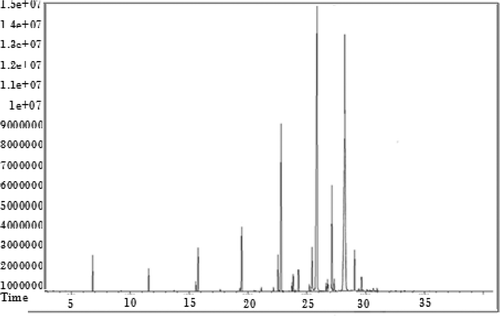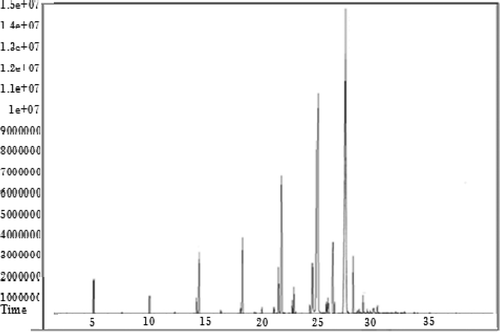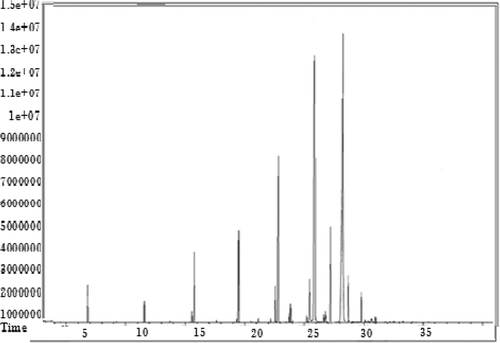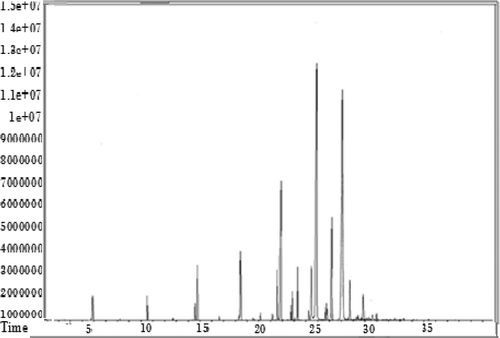Abstract
The effect of low melting fractions of milk fat on oxidative stability of ice cream was investigated. Cream was fractionated at three different temperatures (25, 15, and 10°C), designated as LF-25, LF-15, and LF-10. All the low melting fractions were individually incorporated into ice cream and compared with a control, unmodified milk fat. The other ingredients were the same as in the control. Ice creams were stored at –18°C for six months and sampled every 30 days. Fractionation induced major changes in the fatty acid composition of all fractions. Concentration of short-chain and long chain unsaturated fatty acids increased in the low melting fractions. Peroxide value and anisidine value of LF-10 increased from 0.23 to 3.95 (meq/kg O2) and 3.87 to 8.04. Conjugated dienes of control and LF-10 after six months were 1.39 and 4.72 at the same storage period. The flavor score of LF-10 was more than the control and remained indifferent from the control until two months of storage. After six months, the flavor score of LF-10 dropped by 3.6 points as compared to the control, 1.2 points. Low melting fractions of milk fat can be added in the formulation of ice cream to improve its nutritional value with acceptable sensory attributes. However, storage of ice cream formulated from low melting fractions is not recommended for over 60 days at –18°C.
INTRODUCTION
Ice cream is a frozen dairy product prepared from milk derived and other functional ingredients.[Citation1,Citation2] Milk fat provides body, rich flavor, and typical mouth feel to ice cream.[Citation3] Saturated part of milk fat is criticized for having a detrimental effect on uplifting harmful LDL cholesterol in the human body.[Citation4] Many strategies have been developed to increase the extent of unsaturated fatty acids in ice cream; most of the strategies involve using vegetable oils.[Citation5] Replacement of milk fat with vegetable oils is beneficial for health and from economical viewpoints. The use of vegetable oil in ice cream impairs the flavor of ice cream; customers are not willing to compromise on typical sensory characteristics of ice cream.[Citation6] Lowering or replacement of milk fat results in the decline of short-chain fatty acids that are unique to milk fat, which also exert a negative impression on taste perceptions. The replacement of milk fat with vegetable oils is not an appropriate and widely accepted solution of the problem. The situation demands more than mere blending and replacement practices. Fractionation of milk fat is an unique process that increases the concentration of short-chain fatty acids in the low melting fractions, which have a major contribution in flavor.[Citation7] The fatty acid composition of milk fat fractions was significantly different from the parent milk fat.[Citation8,Citation9] Milk fat with modified fatty acid composition is susceptible to oxidation.[Citation10] Oxidation in ice cream prepared from milk fat with modified fatty acid profile has been studied.[Citation11] The changes in fatty acid composition were created through feeding rumen protected fatty acids. Addition of olein fractions of milk fat in ice cream emulsions considerably improved the whipping ability and overrun.[Citation12] Keeping in view the health and functional benefits of low melting fractions of milk fat; they may be recommended for the use in ice cream on a large scale, but the fate of these fractions from the oxidation point of view has not been fully studied. Therefore, this study was designed to fractionate the milk fat at three different temperature programs and study their oxidative stability in ice cream for a period of six months on the basis of certain chemical and sensory characteristics.
MATERIALS AND METHODS
Materials and Fractionation of Cream
Cream was obtained from Solerco, United Kingdom. The reagents used in this study were HPLC grade and obtained from Sigma Aldrich, UK. Cream was heated to 65°C for 40 min in 2 L Pyrex beakers, gradually cooled down to the fractionation temperature (2°C drop in 5 min). Held at a respective fractionation temperature for 2 h, filtered over Buckner funnel, flask fitted with a vacuum pump (600 mm Hg, Buchi). Fractionation at the respective temperatures (25, 15, and 10°C) was repeated for five times, pooled, stored at –60°C in the biomedical freezer (Sanyo) in polyethylene zip bags and used in this study within one week.[Citation7]
Manufacturing and Storage of Ice Cream
Ice cream was manufactured from olein fractions, separated at 25, 15, and 10°C, designated as LF-25, LF-15, and LF-10, compared with a control; unmodified milk fat. Formulation of control comprised of 10% milk fat, 11% MSNF, 13% sugar, and 0.5% stabilizer and emulsifier.[Citation6] The ice cream mix was heated to 70°C, homogenized on a lab scale one stage homogenizer (APV) at 200 Bar pressure, pasteurized at 85°C for 60 seconds, cooled, aged at 4°C for 16 h and frozen in BLD-300 freezer (China). Overrun of all the treatments was adjusted to 70%; ice cream was filled in polypropylene cups and stored at –18°C for six months. Oxidative stability of ice cream was studied at the interval of one month.
Analysis
Milk fat was extracted from ice cream by following the recommended method.[Citation13] Mehtylation technique was used for the preparation of fatty acid methyl esters as prescribed by.[Citation14] After the completion of methylation, distilled water was added (10 mL) and the contents were transferred to a centrifuge tube (40 mL) and centrifuged for 20 min at 2000 g, followed by drying of hexane layer on sodium sulfate and injected into gas chromatograph (GC) (Hewlett Packard GC System HP 6890) fitted with SP 2560 fused silica capillary column (100 m × 0.25 mm × 0.2 μm), using flame ionization detector (FID), the temperature of injector and detector was 240°C. Identification and quantification of fatty acid methyl esters (FAME) was performed by using internal standards (FAME 37 KT, Sigma Aldrich, UK). Peroxide value, fatty acids, anisdine, and iodine values were determined according to the standard methods of the American Oil Chemist’s Society; Wijs solution was prepared from glacial acetic acid, carbon tetra chloride, iodine resublimed, and iodine tricholride and blank reading was determined against standard 0.1-N sodium thiosulphate solution.[Citation15] Sensory evaluation of ice cream was performed in sensory evaluation booths; 3-digits, randomly coded samples were offered in completely randomized orders in plastic cups. The five trained judges who had previous experience in the detection of oxidation/oxidized flavor were selected from dairy and food processing industries, asked to rate the samples on a sensory evaluation using 9-point scale (9: best; 1: worst) as instructed by Performa.[Citation16] The results of triplicate experiments and triplicate analysis of each sample were expressed as mean ± SD, analyzed by analysis of variance techniques (one way and two way), to find out the significant difference among the treatments, Duncan Multiple Range Test was used.[Citation17]
TABLE 1 Fatty acid composition of low melting fractions of milk fat
RESULTS AND DISCUSSION
Fractionation of milk fat at three specific temperature programs induced marked changes in the fatty acid composition of olein fractions. Concentration of short-chain fatty acids and long chain unsaturated fatty acids tended to increase in the modified version of the fats at all the three fractionation temperatures (). The decline in the concentration of C16:0 and rise in the extent of C18:1 and C18:2 possess a health benefit. The collective concentration of C18:1 and C18:2 in LF-10 increased to 29.11% over the parent milk fat (--). C18:1 has been recognized to have a positive effect in the lowering of harmful LDL-cholesterol from the human body. The dietary recommendations suggest that out of 30% of the total caloric requirement to be fulfilled from fats and oils; 50% should be met from monounsaturated fatty acids to decrease the chances of heart diseases.[Citation18] A 40% decline in the concentration of C16:0 was observed in LF-10. Migration of saturated fatty acids in the stearin fraction and unsaturated fatty acids in the olein fraction created major changes in the fatty acid composition of milk fat fractions over the parent milk fat.[Citation7,Citation8]
Storage period and changed fatty acid composition had a pronounced effect on fatty acid composition of olein based ice creams. C16:0 and C18:0 followed an increasing trend, whereas of C18:1 and C18:2 revealed a declining trend. Concentration of C16:0 and C18:0 enhanced by 2.19 and 1.63% in LF-10 after six months of storage at –18°C. About 3% decline in the concentration of C18:1 was noted in LF-10 at the end of storage period (). C18:2 underwent a serious autoxidation; about 50% of the fatty acid was lost in the oxidative breakdown from the initial value. The changes in the fatty acid composition of ice cream were used an indicator of the autoxidation took place during storage, as accelerated oxidation techniques are normally not used for the assessment of the oxidation status of ice cream. The increase or decrease in the fatty acid concentration was dependent on the extent of autoxidation took place as a function of the degree of unsaturation and storage. Drastic changes in C18:2 could be attributed to the presence of a high degree of unsaturation. The oxidation rate of C18:2 is 12 times more than C18:1.[Citation19] The concentration of unsaturated fatty acids in ice cream decreased during storage by 42 days as a function of enrichment of milk fat with flaxseed oil.[Citation20] Oils having a high degree of unsaturation possess low oxidative stability. Enhancement of unsaturated fatty acids in butter fat significantly reduced its keeping quality.[Citation10]
TABLE 2 Changes in major fatty acids during storage of six months
Free fatty acids of all the treatments and control numerically increased during the storage period of six months (). The classical rise of free fatty acids was not specific to any treatment; virtually all the treatments including control were affected. The rise of free fatty acids is not correlated to the autoxidation phenomenon.[Citation21] Free fatty acids are produced as a result of enzymatic activity, metal ion contamination, presence of moisture in the food systems.[Citation22] The increase of free fatty acids could also be attributed to the presence of lipase enzymes which enter into the milk through the blood stream and can hydrolyze the triglycerides when fat globule membrane is not intact due to any reason.[Citation23] Ice cream mix was homogenized; the fat globule membrane was broken down and plenty of water was also available to support the hydrolytic activities of biocatalysts. Free fatty acids of ice cream increased during storage, regardless of the fatty acid composition.[Citation9] Abdullah et al.[Citation24] reported a slight increase in acidity of ice cream during storage. Free fatty acids have a strong correlation with shelf life and quality of foods; higher amounts of free fatty acids usually give rise to problem of off-flavors and poor keeping quality.[Citation25]
TABLE 3 Effect of olein fractions on free fatty acids% of ice cream
The peroxide value of all the treatments and control increased varyingly during the storage period. It can be seen from the results of that peroxide value shoot up (P < 0.05) in the low melting fractions based ice creams after two months of storage and significant rise was observed in the rest of the storage period in all the treatments. Peroxide value is regarded as one of the most important and useful test for the determination of primary oxidation products.[Citation26] Enhancement of unsaturated fatty acids in milk fat by the fat modification strategies may enhance the autoxidation process.[Citation27] The shoot up of peroxide value could be appropriately attributed to the relatively higher extent of unsaturated fatty acids inducted in olein fractions by the fractionation process. Gonzalez et al.[Citation11] modified the fatty acid composition of milk fat through feeding management, milk with modified fatty acid composition was incorporated into ice cream, significant (P < 0.05) rise in peroxide value was observed after two months of storage. Oxidative stability of ice cream prepared by the addition of flax seed oil was inferior to original milk fat.[Citation20] The peroxide value of butter oil with modified fatty acid profile increased during long term storage.[Citation10] In this study the oxidation rate of C16:0, C18:0, C18:1, and C18:2 were compared; the relative rate of oxidation of these fatty acids is 1:100:1200:2500, respectively, i.e., presence of more unsaturated fatty acids will make the fat vulnerable to autoxidation.[Citation28] The peroxide value of milk fat with altered fatty acid profile was more than the original milk fat.[Citation29]
TABLE 4 Effect of olein fractions on peroxide value (meq/kg) of ice cream
The results of anisidine value of ice cream prepared from low melting fractions of milk fat and control are given in . Anisidine value increased numerically throughout the storage period, significant changes (P < 0.05) could be observed after two months of storage. The maximum rise was observed in LF-10, followed by LF-15, LF-25, and control. The significant difference in anisidine value of ice creams supplemented with low melting fractions of milk fat and control could be rightly correlated to the higher extent of unsaturated fatty acids, which were seriously oxidized and yielded the higher extent of oxidation products during six months storage period. Nadeem et al.[Citation10] recorded higher concentration of oxidation products when butter oil with modified fatty acid profile was stored for three months. The extent of oxidation products in the butter increased during storage.[Citation30] Krause et al.[Citation31] monitored the changes in butter stored at freezing temperature for one year and found higher concentrations of oxidation products as a function of storage. Determination of anisidine value provides useful information about the amount of secondary oxidation products.[Citation32] Gulla and Waghray[Citation33] also observed a strong correlation between the oxidation products and extent of unsaturated fatty acids.
TABLE 5 Effect of olein fractions on anisidine value of ice cream
The results of specific extinctions of fat extracted from ice cream; measured at 232-name is given in . About a 3-fold increase was observed in the concentration of secondary oxidation products in LF-10. Determination conjugated dienes is an important parameter to recognize the status of oxidation products in fats.[Citation34] The higher levels of oxidation products in olein based ice creams gave a clue of the magnitude of oxidation faced by the olein based ice creams, during six months of storage. The concentration of conjugated dienes in LF-10 increased from 0.31 to 4.72. Concentration of conjugated dienes depends upon the extent of oxygen absorbed by the fats.[Citation35] Blends of oils containing higher quantities of polyunsaturated oils yielded higher amounts of conjugated dienes and trienes.[Citation33] Nadeem et al.[Citation10] also observed a rising trend of conjugated dienes when butter oil with elevated levels of unsaturated fatty acids was stored for three months.
TABLE 6 Effect of olein fractions on conjugated dienes of ice cream (1% 1CM [λ232])
Steady increase of oxidation products was observed in all the treatments and control which became significant after two months of storage in all the treatments. Iodine value of all the treatments and control decreased during storage of six months (). The drop in iodine value was more pronounced in LF-10; which was dropped by 1.56 points from the initial value as compared to the drop in control; 0.43 points. The numeric decline in iodine value was due to the saturation of fatty acids during autoxidation by the oxygen. The extent of the drop in iodine value showed a proportional relationship with the degree of unsaturation. Determination of iodine value is an important parameter to know the intensity of autoxidation.[Citation36] Iodine value of sunflower and soybean oil decreased during six months storage.[Citation26] Gulla and Waghray[Citation33] observed that oils rich in polyunsaturated fatty acids responded more to the drop of iodine value. Milk fat with modified fatty acid profile was more vulnerable to autoxidation than normal milk fat.[Citation11,Citation27]
TABLE 7 Effect of olein fractions on iodine value of ice cream
TABLE 8 Effect of olein fractions on flavor of ice cream
It can be seen from the results of that flavor score for all the treatments and control were at par with each other (P > 0.05) in fresh and two months stored olein based ice creams. Whenever the milk fat is fully or partially replaced with vegetable fats or oils, flavor score decreases, even in the fresh ice cream. The addition of vegetable oils in ice cream decreases the concentration of short-chain fatty acids, which are mainly responsible for a typical flavor of milk fat. This is the unique benefit of using low melting milk fat fractions in ice cream over vegetable oils. In this investigation, milk fat fractions were employed in the formulation of ice cream, which has a higher concentration of short-chain fatty acids over normal milk fat. The flavor score tended to deteriorate as the storage period was prolonged. After six months of storage the lowest score was obtained by LF-10 and a decline of 3.6 was observed in flavor score from the initial value. When flavor scores were correlated with oxidation progress, a strong correlation was observed within flavor score and oxidation phenomenon. Determination frequencies showing a higher degree of oxidation showed a lower flavor score.
CONCLUSION
Fractionation of milk fat at three different temperature programs significantly influenced the fatty acid composition of all the low melting fractions. Olein based ice creams endured autoxidation phenomenon, which was speeded after two months of storage, generated higher extents of primary and secondary oxidation products. The results of this study suggest that low melting fractions of milk fat can be used in the formulation of functional ice cream, but it should not be stored for more than two months at –18°C, the storage of olein based ice cream at –30°C may improve oxidative stability.
FUNDING
The authors are highly obliged to Higher Education Commission of Pakistan (HEC) for the provision of funds to complete a part of this research work as a part of PhD research work at Queens University Belfast, The United Kingdom.
Additional information
Funding
REFERENCES
- Dogan, M.; Kayacier, A. The effect of ageing at low temperature on the rheological properties of kahramanmaras-type ice cream mix. International Journal of Food Properties 2007, 10, 19–24.
- Icier, F.; Tavman, S. Ohmic heating behaviour and rheological properties of ice cream mixes. International Journal of Food Properties 2006, 9, 679–689.
- Marshall, R.T.; Goff, R.D.; Hartel, R.W. Ice Cream, 6th Ed; Kluwer Acad/Plenum Pub: New York, USA, 2003; 52.
- Mathur, M.P.; Datta, R.D.; Dinkar, P. Textbook of Dairy Chemistry, Indian Council of Agricultutral Research: New Delhi, 1999; 114.
- Adhikari, K.; Aurora, K.A. Development of mellorine type frozen desserts: Effect of stabilizers and emulsifiers. Indian Journal of Animal Science 1994, 64, 526–533.
- Nadeem, M.; Abdullah, M.; Ellahi, M.Y. Effect of incorporating rape seed oil on quality of ice cream. Mediterranean Journal of Nutrition and Metabolism 2010, 3, 121–126.
- Reddy, S.Y. Improving plasticity of milk fat for use in baking by fractionation. Journal American Oil Chemist’s Society 2010, 87, 493–497.
- Van Aken, G.A.; Ten Grotenhuis, E.; Van Iangevelde, A.J.; Schenk, H. Composition and crystallization of milk fat fractions. Journal American Oil Chemist’s Society 1999, 76, 1323–1331.
- Chen, S.; Bobe, G.; Zimmerman, S.; Hammond, E.G. Physical and sensory properties of dairy products from cows with various milk fatty acids compositions. Department of Food Science, Lowa State University; 2004.
- Nadeem, M.; Abdullah, M.; Khalique, A.; Hussain, I.; Mahmud, A.; Mahmood, T. The effect of Moringa oleifera leaf extract as antioxidant on stabilization of butter oil with modified fatty acid profile. Journal of Agricultural Science and Technology 2013, 15 (5), 919–928.
- Gonzalez. S.; Duncan1, S.E.; Sumner, S.S.; Keefe, S.S.O.; Herbein, J. Oxidation and textural characteristics of butter and ice cream with modified fatty acid profiles. Journal Dairy Science 2003, 86, 70–77.
- Bazmi, A.; Relkin, P. Effects of processing conditions on structural and functional parameters of whipped dairy emulsions containing various fatty acid compositions. Journal Dairy Science 2009, 92, 3566–3574.
- AOAC. Official Methods of Analysis, 16th Ed; Association of Official Analytical Chemists, AOAC International, Gaithersburg, MD, 1997.
- Ostrowska, E.; Muralitharan, M.; Cross, R.F.; Bauman, D.E.; Dunshea, F.R. Dietary conjugated linoleic acid increase lean tissue and decrease fat deposition in growing pigs. Journal of Nutrition 2000, 129, 2037–2042.
- AOCS. Official Methods and Recommended Practices of the American Oil Chemists’ Society, 4th Ed; AOCS, Champaign, IL, USA, 1995.
- Larmond, E. Laboratory Methods for Sensory Evaluation of Foods, Ottawa Publications: Research Branch, Department of Agriculture, Canada, 1987.
- Steel, R.G.D.; Torrie, J.H.; Dickey, D.A. Principles and Procedures of Statistics. A Biometrical Approach, 3rd Ed; Mc-Graw Hill Book Co.: New York, 1997.
- Mensink, R.P.; Katan, M.B. Effect of dietary trans-fatty acids on high-density and low density lipoprotein cholesterol levels in healthy subjects. Journal of Clinical Nutrition 1990, 323, 439–445.
- Reynhout, G. The effect of temperature on induction time of stabilized oil. Journal American Oil Chemists Society 1991, 68, 983–984.
- Lim, C.W.; Norziah, M.H.; Lu, H.F.S. Effect of flaxseed oil towards physicochemical and sensory characteristic of reduced fat ice creams and its stability in ice creams upon storage. International Food Research Journal 2010, 17, 393–403.
- Fereidoon, S. Bailleys Industrial Edible Oil and Fat Products, 6th Ed; John Willey and Sons, Pub. Co.: NY, 2005.
- Mc Sweeny, P.L.H.; Fox, P.F. Advanced Dairy Chemistry, Vol. 1 Proteins. 3rd Ed; Kluwer Academic Plenum Pub: New York, 2003.
- Fox, P.F.; McSweeney, P.L.H. Dairy Chemistry and Biochemistry. Blackie Academic and Professional, NY. 1998.
- Abdullah, M.; Rehman, S.; Zubari, H.; Saeed, H.M.; Kousar, M.; Shahid, M. Effect of skim in soymilk blend on the quality of ice cream. Pakistan Journal of Nutrition 2003, 2, 305–311.
- Potter, N.W.; Hotchkis, J. Food Science. AVI Publishing Co. Inc: NY. 1998.
- Anwar, F.; Hussain, A.I.; Iqbal, S.; Bhanger, M.I. Enhancement of the oxidative stability of some vegetable oils by blending with Moringa oleifera oil. Food Chemistry 2007, 103, 1181–1191.
- Ashes, J.R.; Gulati, S.K.; Scott, T.W. Potential to alter the content and composition of milk fat through nutrition. Journal Dairy Science 1997, 80, 2204–2212.
- deMan, J.M. Lipids, Chapter 2 in Principles of Food Chemistry, Aspen Publishers: 1999; 33–81.
- Baer, R.J.; Ryali, J.; Schingoethe, D.J.; Kasperson, K.M.; Donovan, D.C.; Hippen, A.R.; Franklin, S.T. Composition and properties of milk and butter from cows fed fish oil. Journal Dairy Science 2001, 84, 345–353.
- Nadeem, M.; Abdullha, M.; Hussain, I.; Inayat, S.; Javid, A.; Zahoor, Y. Antioxidant potential of Moringa oleifera leaf extract for the stabilization of butter oil at refrigeration temperature. Czech Journal of Food Sciences 2013, 13 (4), 332–339.
- Krause, A.J.; Miracle, R.E.; Sanders, T.H.; Dean, L.L.; Drake, M.A. The effect of refrigerated and frozen storage on butter flavor and texture. Journal Dairy Science 2008, 91, 455–465.
- Erickson, D.R. Practical Hand Book of Soybean Processing and Utilization. AOCS press. 1999.
- Gulla, S.; Waghray, K. Effect of storage on physico-chemical characteristics and fatty acid composition of selected oil blends. Journal Lipid Science 2011, 3, 35–46.
- McGinely, L. Analysis and quality control for processing and processed fats. In: Analysis of Oilseeds, Fat, and Fatty Food; Rossell, J.B.; Printed, J.L.R.; Eds.; Elsevier Applied Science: NY, 1991; 440–470.
- Bushra, S.; Farooq, A.; Roman, P. Antioxidant potential of corncob extracts for stabilization of corn oil subjected to microwave heating. Food Chemistry 2007, 104, 997–1005.
- Anwar, F.; Bhanger, M.I.; Yasmeen, S. Antioxidant activity of some natural extracts in corn oil. In: Advanced Research of Plant Lipids; Murata, N.; Yamada, M.; Nishida, I.; Okuyama, H.; Sekiya, J.; Hajime, W.; Eds.; Kluwer Publishers: The Netherlands, 2003; 24–27




